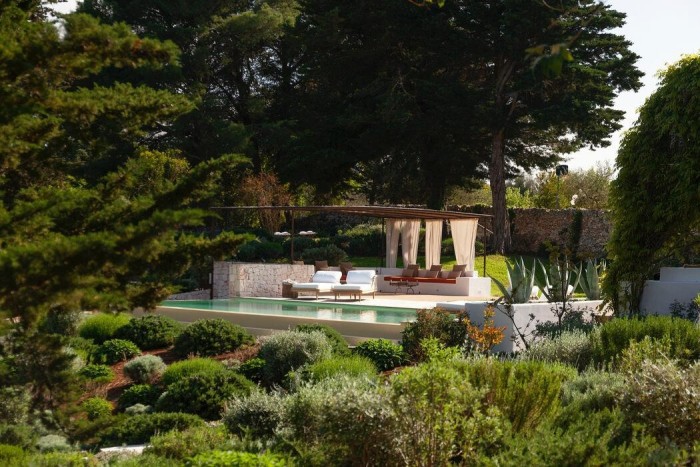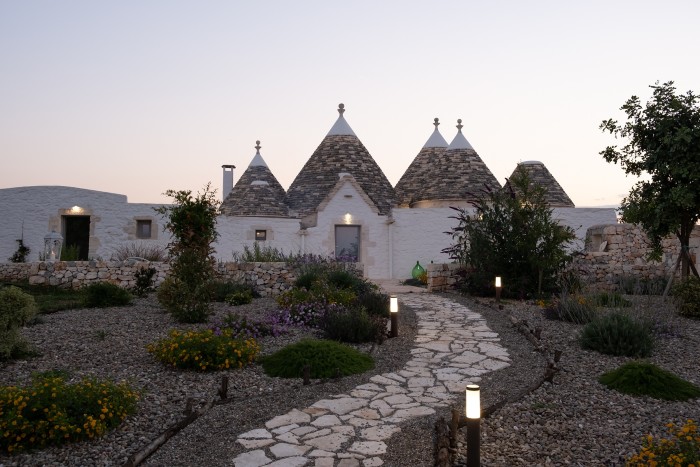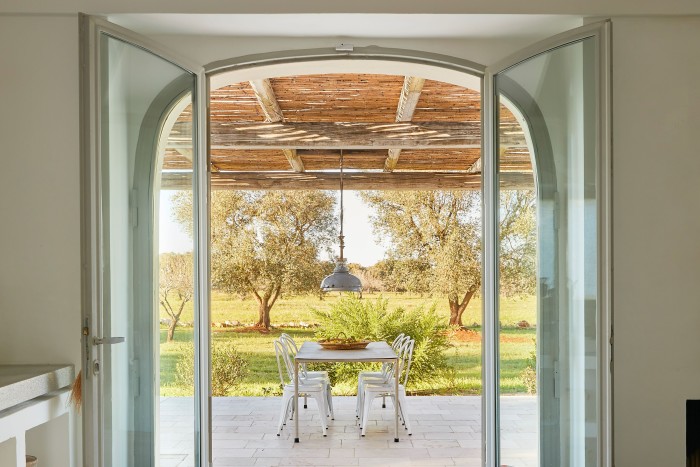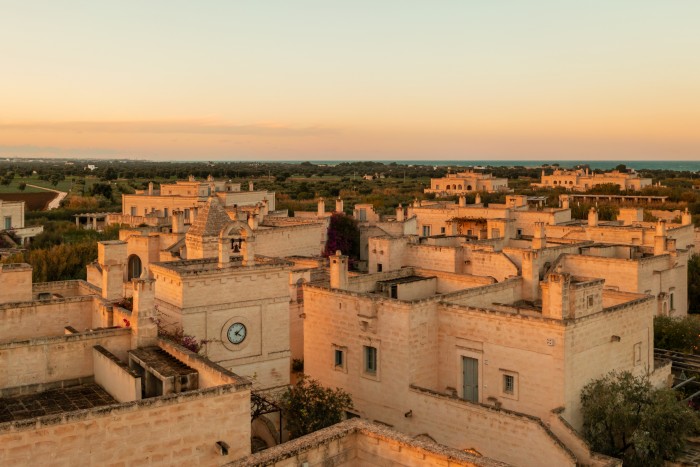
There was rain in the night, and in the morning the scent of warm cypress and fallen pine needles mingled with that of lavender and rosemary. Stepping out into the garden of La Dimora dei Semplici, our villa near Ostuni, was like breathing in the raw essence of the Mediterranean south.
Although I had passed several times through the heel of Italy, heading to ferry crossings in Bari or Brindisi, this was my first time lingering long in Puglia and properly soaking up its many pleasures. Here the towns and villages cluster on hilltops, looking down on to vistas of vines and olives; yet it still feels a world away from the more familiar landscapes of central Italy, with an aesthetic of its own.
No one knows if it is a legacy of south Italy’s centuries under Greek-Byzantine rule, but in Puglia the buildings are whitewashed. That dazzling white, lit by the brilliant southern sun, forms the backdrop to the trellises of vines and pots of oleanders and rosemary. The white mansions are often topped by white gables, white chimney stacks and white baroque finials.

In some hill towns, such as Alberobello, the streets are full of whitewashed roundhouses that rise into conical roofs, like lapidary witches’ hats or stone candle snuffers. These are known as trulli, an Italianised form of the Greek word for cupola. They are believed to derive from an early form of ancient Greek dwelling, long since disappeared in Greece itself.
Here the olive groves are edged by honey-coloured drystone walls that curl and snake down to the coast like long limestone serpents. As we looked down from the hills around Ostuni, through frames of cupola-topped campaniles and avenues of slender cypress, the silver of the olives gave way in the coastal plain to the gold of ripe wheat. Beyond lay pebbly coves and some of Italy’s loveliest, emptiest white beaches, washed by an azure sea.
I had come to Puglia to search for one of its greatest kings. In particular, I wanted to visit his favourite residence and most remarkable creation, Castel del Monte. This is a 13th-century castle turned hunting lodge that is one of the wonders of medieval Italy.

Castel del Monte was built by the brilliant Holy Roman emperor and king of Jerusalem, Germany, Italy and Sicily, Frederick II (1194-1250), known as “Stupor Mundi”, or Wonder of the World. Frederick was a freethinking intellectual, a scholar and a statesman, polymath and philosopher. He was also an enthusiastic ornithologist, and fluent in five languages including Greek and Arabic. He had great charm and could dazzle anyone with the quickness of his wit.
“I found him to excel in the rational sciences,” reported one Arab ambassador, “and he is distinguished among all the Franks for his talents, his intelligence and his taste for philosophy, logic and medicine.”
Frederick liked to surround himself with men of genius drawn from the diverse communities over which he ruled — Arab, Greek and Jewish as well as Latin Catholic. He patronised scholarship among all faiths across the Mediterranean.

Above all, Frederick was fascinated by numbers, and he championed Arabic numerals as better suited for both calculation and business than their Roman equivalents (if you doubt this, just try multiplying MCXVI by MCCIV).
If mathematics was one of Frederick’s great loves, then hunting was another. His book on falconry, On the Art of Hunting with Birds, which drew on Arab sources, opens with the simple maxim: “Our purpose is to present the facts as we find them . . . One should accept as truth only that which is proved by the force of reason and by nature.”
Both interests came together at Castel del Monte, built to house the emperor during his holidays in Puglia. With its dazzling simplicity and perfect geometry, based on a succession of octagons, it is the most flawless of all medieval European castles, and one whose classical elements and harmony of proportions anticipate the experiments of the Renaissance by 200 years.


Although Frederick controlled territory from the Rhine to Sicily, it was Castel del Monte that was his favourite destination, and it was here that he kept many of his leopards and lynxes, looked after by skilled Muslim trainers. Its plan seems to have been strongly influenced by Islamic architecture and its unusual design may have its origins in the two months Frederick spent near the Dome of the Rock in Jerusalem.
Today, the castle, perfectly preserved, still rises on a wooded hill above a chequerboard of vineyards and olive groves, inland from what was in Frederick’s day the main port of Puglia, the beautiful fishing town of Trani, itself defended by an extraordinary, almost modernist fortress that looks as if it could have been built by IM Pei.
Like Trani, Castel del Monte is built in a light, feta-coloured limestone, a dazzling white octagon out of which emerge eight octagonal corner towers. Here was the perfect place for the emperor to discuss questions of science, astronomy and philosophy with his savants, and it was here that he kept his astronomical instruments.
Today, the castle’s maze of 16 rooms with highly vaulted ceilings and superb marble fireplaces and capitals, all built around an octagonal courtyard, still perfectly show off the sacred geometry that fascinated Frederick. A Unesco World Heritage Site, it was the obvious choice for the filming of the celebrated library scenes in Umberto Eco’s fabulous medieval detective story, The Name of the Rose.
Frederick was a model of inquisitive tolerance and multiculturalism in an age of religious absolutism. It only amused him that he was denounced in some clerical quarters as the Antichrist or the Beast of the Apocalypse. Nor did it help his reputation with suspicious churchmen that he surrounded himself with Arab light cavalry and archer-bodyguards, as well as an Arab tutor of logic.



In 1222, Frederick made the decision to move all the remaining Arabs from Sicily to the hilltop town of Lucera, a day’s march across the Puglian plateau to the north of Castel del Monte. The following year, some 40,000 Sicilian Muslims crossed the Strait of Messina and made a new home for themselves in northern Puglia, where they were given far more fertile and prosperous land than the mountains they had come from. The town was, and remains, exceptionally beautiful. Its loveliness derives in part from the quality of its light, something the Romans noted when they first named it Luceria, or “Circle of Shining Light”.
It was in Lucera that Frederick built the biggest of his castles. With its towering walls, pentagonal Arab-style bastions and machicolations and rock-cut moat it remains his single most massive construction, defended by a complex system of ropes and drawbridges that made entry by invaders impossible. Inside, he maintained a palace decorated with superb Islamic tile work.
Here he kept his harem and eunuchs, as well as his celebrated troop of Saracen girls who danced on top of rolling balls. Here too he encouraged the Arabs to set up their looms for silk weaving and the forges and workshops they needed to manufacture their specialist weaponry, such as bows, arrows and shields. It was also in the castle of Lucera that Frederick experimented with camel breeding.
For half a century, Lucera was a functioning Islamic city. According to the Arab commentator Abū al-Fidā, “In the town of Lucera, all the inhabitants are Muslims from Sicily, and there the Friday sermon is held, the banners of Islam wave, the calls to prayer rings out, and many of the king’s entourage are Muslims.” What Granada was to Spain, Lucera was to Italy.
The story of the Lucera Arabs is a tale with echoes of the last sigh of the Spanish Moors, but one that is much less well known. For while the Lucera Muslim colony flourished under Frederick, it met a terrible fate after his death. In 1295, nearly 50 years after its protector had passed away, under the rule of Charles II, Dominican inquisitors and preachers were unleashed on Lucera, determined to either convert, enslave or kill the remaining Muslims.
It is a tragic story. But like the lost Moors of Granada, the Arabs of Lucera left a lingering aesthetic influence that can still be admired. As well as the Arab-style fortress, in the centre of the town there is the attractive patterned-brick duomo, which has a many-tiered octagonal campanile that some observers have suggested might have been built from an earlier minaret; the cathedral itself sits on the site of what had been the town’s mosque. Nearby is the muqarnas-eaved Church of San Domenico, on the site of what was once probably a madrassa, outside which is a former Sufi shrine that is now a chapel. Here, a very Islamic-looking pointed parabolic dome is set on an octagon.
Elsewhere in this stunning town are many other traces of Lucera’s Islamic century: carved wooden ceilings, Moorish onion domes, Islamic cupolas, pepper-pot turrets and pigeon towers resembling those in the Maghreb.


There is more evidence of the skills of Lucera’s Saracen sculptors in the Romanesque duomo of the next town, Troia. You climb up through the fields, then pass along ever narrower streets to reach a tiny piazza facing on to one of the loveliest small cathedrals in all Italy.
Moorish crescent moons, eight-pointed stars, interlaced medallions, latticed jali screens and interwoven griffins and other exotic winged quadrupeds of Persian inspiration hint at the identity of the cathedral’s craftsmen. Yet their skills turned to Christian art. Most remarkable of all is the filigree latticework rose window of cut stone that fills the west end of the cathedral and casts into the nave variegated light and shadow, which flickers on the flagstones and whose closest counterpart can be found in the mosques of Algeria.
Troia might be the most perfect small town in Puglia, the ideal place to sit with a glass of Puglian white wine as the sun goes down, to contemplate the incredibly rich and almost forgotten legacy of this gorgeous Italian Granada.
William Dalrymple was a guest of La Dimora dei Semplici (see details below) and The Thinking Traveller (thethinkingtraveller.com)
Where to stay in Puglia

La Dimora dei Semplici Between Ostuni and Martina Franca in the Itria valley, La Dimora dei Semplici (pictured above) has been created out of five 18th-century trulli and former stables. There are two independent wings — each with three double bedrooms — which can be rented separately or together. Each has a salt-water swimming pool formed from original cisterns, one previously used for gathering rainwater, the other for making wine. The property is powered by renewable energy and there are two organic vegetable patches. The gardens feature lawns, wisteria-covered pergolas, centuries-old trees and bushes of sage, thyme and lemon balm. Each wing sleeps six and costs from €800 per night; dimoradeisemplici.it

Ottoconi The Thinking Traveller began life in Sicily but expanded to Puglia in 2009 and now offers almost 60 villas in the region, from trulli for two to historic pallazzi — and even a 16th-century castle sleeping 22. Ottoconi is more modest but just as delightful, an amalgamation of trulli and a lamia (a traditional stone farmhouse with vaulted ceilings) surrounded by wheat fields and olive groves between the towns of Martina Franca and Alberobello. The interior blends modern bathrooms and kitchen with ancient stone walls, flagged floors and wooden beams. Sleeps six, from £3,027 per week; thethinkingtraveller.com

Villa Castelluccio Nine miles south of Ostuni, Villa Castelluccio is set in five acres of olive groves. It has been carefully restored from the ruin of a lamia, a project overseen by architect Andrew Trotter. There’s a swimming pool in the gardens, which are filled with lavender, prickly pears, and citrus and fig trees, as well as an outdoor kitchen on a large covered terrace. It’s part of Moroseta Homes, a collection of nine houses to rent in Puglia. Sleeps up to six; from €4,000 per week; masseriamoroseta.it

Borgo Egnazia For those looking for a hotel rather than a villa, Borgo Egnazia has won prizes and loyal fans since it opened in 2009. A recreation of a traditional Puglian borgo, or fortified village, it was built (in tufa limestone) from scratch but don’t fear any theme-park fakery — Condé Nast Traveller called it “the prettiest hotel in the Mediterranean”. There are 183 rooms spread among the cottages, town houses and other buildings, a bell-towered church and central piazza, numerous bars and restaurants (one with a Michelin star), all a short walk from the coast. Doubles from €429; borgoegnazia.com
Find out about our latest stories first — follow FTWeekend on Instagram and X, and subscribe to our podcast Life and Art wherever you listen